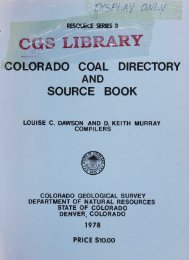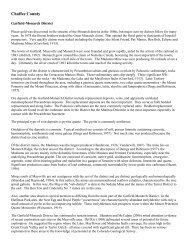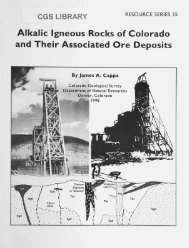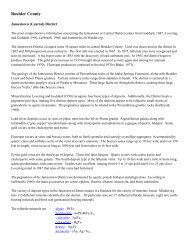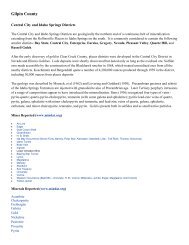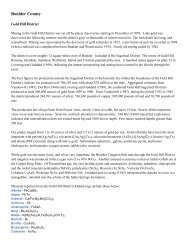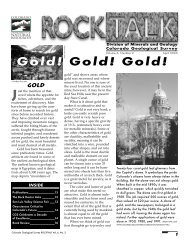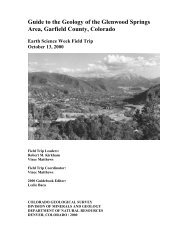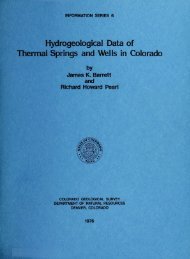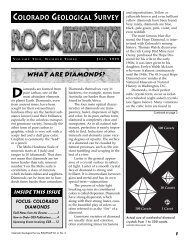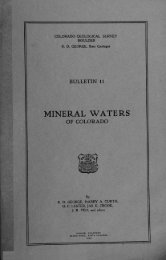Marble - Colorado Geological Survey
Marble - Colorado Geological Survey
Marble - Colorado Geological Survey
You also want an ePaper? Increase the reach of your titles
YUMPU automatically turns print PDFs into web optimized ePapers that Google loves.
(67) Quartzite, dark greenish gray 5 G 4/1,<br />
fine grained with stringers of light greenish<br />
gray 5 G 8/1 fine crystalline quartz. Rock is<br />
apparently nearly pure quartz and possibly<br />
owes it greenish color to minor finely<br />
disseminated chlorite; chlorite crystals were<br />
not seen. Limonite stains are present on one<br />
edge of sample. (Sample not digested.)<br />
(68) <strong>Marble</strong>, dark gray N3, fine crystalline<br />
with tightly interlocked calcite crystals from<br />
0.1 to 0.5 mm across. Crystals are same color<br />
as hand specimen owing to presence of ca. 1-2<br />
percent organic impurities and very minor less<br />
than 0.1 percent magnetite contained within<br />
the crystals. Rock shows excellent resistance to<br />
disaggregation and on weathered surface shows<br />
little staining.<br />
(69) <strong>Marble</strong>, medium gray N5 with bands<br />
ranging up to very light gray N8, coarse crystalline<br />
with crystals ranging from 1.0-4.0 mm<br />
across. Calcite crystals are tightly interlocked.<br />
Lighter bands contain 1 to 2 percent slightly<br />
oxidized magnetite and very minor less than<br />
0.1 percent pyrite. Darker N5 areas contain<br />
very minor ca. 0.1 percent iron minerals. Crystal<br />
color is same as hand specimen owing to<br />
less than 1 percent organic impurities contained<br />
within crystals. Rock shows good resistance<br />
to disaggregation on fresh surfaces and poor<br />
resistance where weathered.<br />
(70) <strong>Marble</strong> as (69) except larger crystals<br />
range upwards to 6 mm across and the magne<br />
tite is oxidized to hematite/limonite resulting<br />
on a 2.5 YR 4/8 red splotchy staining in the<br />
otherwise near white bands.<br />
71) <strong>Marble</strong>, medium gray N5 coarse crystalline<br />
with calcite crystals from 1.0 to 2.0 mm<br />
across with calcite crystals tightly interlocked.<br />
Calcite crystals are the same color as hand<br />
specimen owing to organic impurities and clay<br />
making up less than 1.0 percent of them. Very<br />
minor less than 0.1 percent magnetite and<br />
pyrite. An unidentified dark yellowish orange<br />
10 YR 6/6 mineral, possibly sphene, forms less<br />
than 0.1 percent of the rock. Stubby, prismatic<br />
crystals 0.2-0.5 mm across do not disaggregate<br />
or oxidize to stain or deteriorate adjacent calcite<br />
crystals. Rock exhibits good resistance to<br />
disaggregation except on weathered surface(s).<br />
(72) Metaquartzite, hydrothermal ironsulfide<br />
mineralized. Protolith of rock probably<br />
is a quartz sandstone with a small amount of<br />
clay or a quartz porphyry intrusive. Rock consists<br />
of veinlets of finely disseminated crystalline<br />
pyrite and minor magnetite? in a matrix y<br />
N9 near white five grained crystalline quartz.<br />
Biotite and phlogopite ? are distributed in<br />
small 0.5 mm masses throughout the rock.<br />
Estimated percentages of minerals are quartz<br />
75 percent pyrite 15 percent, biotite/phlogopite<br />
? 9+ percent, other undetermined constituents<br />
1 percent. Note: There is a very small amount<br />
0.1 percent of a soft jade-green mineral that<br />
was not determined.



